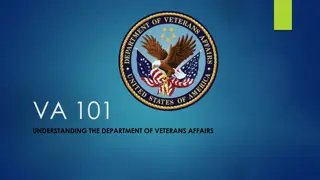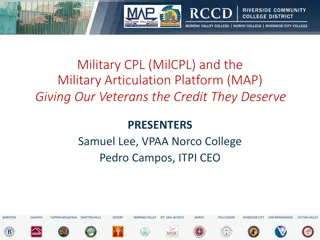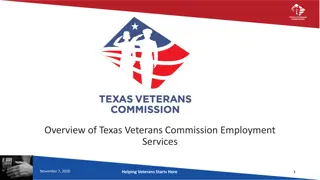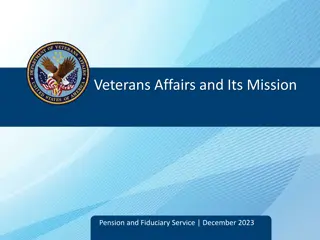Insights on Animal Research Topics for Serving Veterans
Explore current animal research topics focused on serving veterans, including updates from the VA Office of Research and Development, USDA annual reviews, ordering feed/bedding efficiently, and IACUC oversight. Learn about principles for conference participation and national contracting documents for animal research vendors.
Download Presentation

Please find below an Image/Link to download the presentation.
The content on the website is provided AS IS for your information and personal use only. It may not be sold, licensed, or shared on other websites without obtaining consent from the author.If you encounter any issues during the download, it is possible that the publisher has removed the file from their server.
You are allowed to download the files provided on this website for personal or commercial use, subject to the condition that they are used lawfully. All files are the property of their respective owners.
The content on the website is provided AS IS for your information and personal use only. It may not be sold, licensed, or shared on other websites without obtaining consent from the author.
E N D
Presentation Transcript
A15: Current Animal Research Topics Doing Right by the Animals to Serve Veterans Michael Fallon, DVM, PhD, DACLAM CPIA Susan Harper, DVM, MS, DACLAM, DACVPM Alice Huang, Ph.D, CPIA Joan Richerson, MS, DVM, MS, DACLAM, CPIA 1
PRIM&Rs Principles and Expectations for Participation in Conferences The objective of PRIM&R s conferences is to provide a safe and respectful environment for attendees to increase their knowledge and understanding of ethical and regulatory requirements, learn best practices, grapple with both late-breaking and longstanding challenges, and confer with peers and experts in the research ethics field in a constructive way. To that end, PRIM&R will not tolerate the disruptions that result in: The inability for learning objectives of sessions to be met; The inability for dialogue, discussion, debate, learning, and/or networking to take place; Harassment, badgering, or verbal threats; The use or threat of physical force by any individual or group of individuals against another; and/or Destruction of property. In the interest of promoting learning for all participants, please keep questions and comments brief and on-point to the session topic, identify yourself when you ask your question, and be mindful of others who wish to participate in the discussion. For more information on this policy, please visit www.primr.org/principles. 2
Topics for Today's Session VA Office of Research and Development Update Ordering Feed/Bedding Missed USDA Annual Reviews IACUC Review by VVC Guide Deviations and Departures VA Office of Research Oversight Update Q&A / Discussion 3
National Contracting Documents Available- Feed and Bedding Instructions on how to most efficiently order common feed and bedding products are available on the ORD animal research web page for the following vendors: - Harlan/Teklad - Purina - Bio-Serve - The Andersons - NEPCO - PJ Murphy - Biofresh - Ancare 4
USDA Annual Reviews USDA AWAR, 2.31 - Institutional Animal Care and Use Committee (IACUC), item (d)(5): "The IACUC shall conduct continuing reviews of activities covered by this subchapter at appropriate intervals as determined by the IACUC, but not less than annually;" 5
Assumptions If an annual review for a regulated species is not approved within 365 days of initial approval of the last annual review approval: All work on the protocol must stop until the IACUC approves the annual review (no non- compliance ocurred) If work continues, the IACUC must report to VA that unapproved work was conducted and report to USDA that work had to be suspended (non- compliance incurred; reporting to USDA and any Federal agency funding the work per USDA AWAR 2.31(d)(7)) 6
Previous Assumption Clarification Failure of the IACUC to complete an annual review means that IACUC approval of the protocol has lapsed, and work must stop on the protocol. Failure of the IACUC to complete an annual review does NOT mean approval of the protocol has lapsed, and work may continue. If investigator continues work, IACUC must suspend and report to ORO, ORD, and USDA If investigator continues work, USDA does not consider that to be a reportable matter. Due to VA Handbook 1058.01, must still report to ORO The IACUC must "approve" annual reports. The IACUC must "review" annual reports per 2.31(d)(7). If the IACUC fails to compete the continuing review in time (recently interpreted by USDA to mean by the end of the month in which the anniversary date falls), it might have to be reported because the protocol would be suspended. Failure to complete the annual continuing review on time is failure to comply with AWAR, but it is not reportable to USDA, and no suspension is needed (a VMO could cite it during a visit, but such visits are rare for VA). -Changes to a protocol incorporated into the annual review form must be approved by the IACUC before being implemented. -Late PHS trienniel reviews are reportable No change. 7
USDA Annual Reviews Contact: Dr. Nicolette Petervery Regional Animal Care Specialist USDA APHIS Animal Care Eastern Region Moving forward: if all VA stakeholders clear, guidance will be released 8
VVC What is VVC? and When Does It Come into Play? 9
What is VVC? Veterinary Verification & Consultation For changes in an IACUC-approved protocol IACUC-approved policy must be in place for the change requested Veterinarian determines whether IACUC-approved policy is applicable 10
IACUC-Approved Policies May be in the form of Guidance documents Standard Operating Procedures (SOPs) Drug formularies Must be reviewed for accuracy and appropriateness, and re- approved by IACUC at least every 3 years, to stay in effect 11
What Does the Veterinarian Do with the Policy? Review the change proposed Evaluate whether the proposed change is covered by an IACUC- approved policy Make a professional judgment as to whether it is appropriate to apply the policy in this specific case 12
When Does VVC Come Into Play? A Familiar Scenario Work is proceeding according to protocol Something unexpected happens The investigator needs to respond by doing something different from what is in protocol How should this be handled? 14
A Specific Example Dr. Zauberfinger, the PI Dr. Tierartzt, the veterinarian The IACUC 15
Question 1 Is it compliant with regulatory requirements if Dr. Zauberfinger switches to isoflurane anesthesia for this animal, when his IACUC-approved protocol makes no mention of isoflurane? 16
It is the veterinarians responsibility to oversee the well-being and clinical care and promoting animal well-being at all times (Guide, p. 105) The change to isoflurane Is for the well-being of the animal According to the professional judgment of the veterinarian So, no IACUC approval is required 17
Question 2 What if Dr. Zauberfinger wants to switch to isoflurane routinely, without having to ask the veterinarian, if any animal on the protocol turns out to need more than 2 anesthetic supplements? 18
Change in Approved Protocol (familiar mechanisms) Significant Changes generally will have, or have the potential to have, negative impacts on animal welfare or personnel safety Other Changes are mainly related to documentation or project management Corrections of typos/grammar Updates of contact information Personnel other than PI Procedures Locations Species Objectives PI Increased numbers (do not require IACUC approval) (require IACUC approval) 19
Change in Approved Protocol Significant Changes generally will have, or have the potential to have, negative impacts on animal welfare or personnel safety Other Changes are mainly related to documentation or project management Corrections of typos/grammar Updates of contact information Personnel other than PI Procedures (including changes in anesthesia) Locations Species Objectives PI Increased numbers (do not require IACUC approval) (require IACUC approval) 20
Question 3 What if the IACUC determines that it is generally acceptable for protocols that involve ketamine/xylazine anesthesia to be modified to allow switching to isoflurane after two supplementary doses of the injectable anesthetic? 21
Significant Changes Require IACUC Approval Familiar *NEW* DMR or FCR required Amendment must be submitted for IACUC review Eligible for VVC Only if DMR/FCR is not specifically required, and if IACUC-approved policy is in place Nonsurvival Survival surgery pain, distress, invasiveness Move to housing not already under IACUC oversight species study objectives PI anesthesia, analgesia, sedation, or experimental substances euthanasia to method approved by AVMA duration, frequency, type, or number of procedures 22
Significant Changes Require IACUC Approval DMR or FCR required Amendment must be submitted for review Eligible for VVC Only if DMR/FCR is not specifically required, and if IACUC-approved policy is in place Nonsurvival Survival surgery pain, distress, invasiveness Move to housing not already under IACUC oversight species study objectives PI anesthesia, analgesia, sedation, or experimental substances euthanasia to method approved by AVMA duration, frequency, type, or number of procedures 23
Keep in mind It s up to the IACUC to decide what policies to establish draft with care Veterinarian may be any veterinarian acceptable to the IACUC is not performing DMR Approval is granted by the IACUC, in approving the policy (not by the veterinarian) Veterinarian may decide not to apply the policy All changes in an approved protocol must be documented 25
Guide Deviations & Departures Still Confused? Presented By Joan Richerson, MS, DVM, MS, DACLAM, CPIA Assistant CVMO This presentation has been reviewed by OLAW and found to be consistent with PHS Policy . 26
Proposed Research Study Dr. Sarah Bennett has developed a new experimental drug (BPL-23) that appears to be effective in lowering blood pressure and seems to have fewer side effects than other drugs in use. She will be testing BPL-23 in a transgenic line of mice that she has developed over the last five years; her meticulous records show that trio-breeding has resulted in a higher conception rate and higher pup survival. 27
Continued Once the mice are weaned, hypertension is induced by feeding a high salt diet and adding a hypertensive compound (pharmaceutical grade) in their drinking water. The mice will also have a radiotelemetry device implanted to record blood pressure and will be individually housed until their surgical incisions heal. Before and after BPL-23 administration, mice are housed singly in metabolic cages with wire mesh floors for the collection of 24 hour urine samples to assess urine volume, Na excretion, and K excretion over 5 days. 28
IACUC Concerns 1. Non-pharmaceutical grade drug 2. Trio-breeding 3. Metabolic cages with wire mesh floors 4. Compound in drinking water to induce hypertension 5. Single housing post-surgery and for 24 hour urine collection for 5 days 29
Investigatorquestions Dr. Bennett has asked you to look over her protocol before she submits it to the IACUC office. She remembers that you have previously told her that the use of non- pharmaceutical agents (IACUC concern 1) and trio breeding (IACUC concern 2) are specifically established exceptions to the Guide. Dr. Bennett explains the rationale behind each deviation using the VA flowchart. 30
1. Non-pharmaceutical grade drug Pg. 31- The use of non-pharmaceutical -grade chemicals or substancesshouldbe described and justified in the animal use protocol and be approved by the IACUC ; for example the use of a non- pharmaceutical-grade chemical or substance may be necessary to meet the scientific goals of a project or when a veterinary of human pharmaceutical-grade product is unavailable. Specifically established Guide exception based on scientific justification that has been reviewed and approved by the IACUC; has no reporting requirements. 31
1. Non-pharmaceutical grade drug Type equation here. 32
2. Trio breeding Pg. 56 The space recommendations presented here are based on professional judgment and experience. Adjustments to the amount and arrangement of space recommended in the following tables should be review and approved by the IACUC and should be based on performance indices related to animal well-being and research quality Specifically established Guide exception based on a performance standard and has no reporting requirements. 33
IACUC Concerns 3.-5. Dr. Bennett is not so confident about how to categorize concerns 3.-5; she thinks they may be approved departures. Her confusion comes from some of the statements in the Guide; she shows you these statements and asks for your help: 3. Metabolic cages with wire mesh floors 4. Compound in drinking water to induce hypertension 5. Single housing post-surgery and for 24 hour urine collection for 5 days. 35
Guide excerpts Related to 3. Metabolic cages with wire mesh Pg. 51 Flooring should be solid, perforated, or slatted with a slip-resistant surface. If wire-mesh flooring is used, a solid resting area may be beneficial, as this floor type can induce foot lesions in rodents and rabbits (Drescher 1993; Fullerton and Gilliatt 1967: Rommers and Meijerhof 1996). Pg. 52 Animals should have adequate bedding substrate and/or structures for resting and sleeping Moreover, it absorbs urine and feces to facilitate cleaning and sanitation. 36
3. Metabolic cages w/ wire mesh Pg. 51 Flooring should be solid, perforated, or slatted with a slip-resistant surface. If wire-mesh flooring is used, a solid resting area may be beneficial, as this floor type can induce foot lesions in rodents and rabbits. Not really applicable, but flooring will be slip resistant and there is an optional may statement. Pg. 52 Animals should have adequate bedding substrate and/or structures for resting and sleeping Moreover, it absorbs urine and feces to facilitate cleaning and sanitation. Based upon general scientific justification no deviation. 37
Guide excerpts related to 3. Metabolic cages w/ wire mesh continued Pg. 121 [Distress] For example, an injection requiring brief immobilization may produce acute stress lasting only seconds, while long-term individual housing of a social species in a metabolic cage may produce chronic distress. Not applicable because the mice are only held in metabolic cages for 5 days. 38
Guide excerpts related to 4. Compound in drinking water to induce hypertension Pg. 25 The following topics should be considered in the preparation of the protocol by the researcher and its review by the IACUC: nonstandard housing and husbandry requirements. Pg. 67 Animals should have access to potable, uncontaminated drinking water according to their particular requirements. 40
4. Compound in drinking water to induce hypertension Pg. 25 The following topics should be considered in the preparation of the protocol by the researcher and its review by the IACUC: nonstandard housing and husbandry requirements. The investigator and IACUC will consider those topics no deviation. Pg. 67 Animals should have access to potable, uncontaminated drinking water according to their particular requirements. The animals will have access to potable water per their (IACUC-approved) requirements no deviation. 41
4. Compound in drinking water to induce hypertension NodeviationfromtheGuide 42
5. Single housing post-surgery and for 24 hour urine collection All excerpts (Pg. 51, 60, and 64) are applicable but Pg. 60 is probably the most applicable. If necessary to house animals singly for example, when justified for experimental purposes, this arrangement should be for the shortest duration possible. Specifically established Guide exception based on scientific justification that has been reviewed and approved by the IACUC; has no reporting requirements. 43
Guide excerpts related to 5. Single housing post-surgery and for 24 hour urine collection Pg. 51 Social animals shouldbe housed in stable pairs or groups of compatible individuals unless they must be housed alone for experimental reasons or because of social incompatibility. Pg. 60 If necessary to house animals singly for example, when justified for experimental purposes, for provision of veterinary care, or for incompatible animals this arrangement should be for the shortest duration possible. 44
Guide excerpts related to 5. Single housing post-surgery and for 24 hour urine collection Pg. 64 Appropriate social interactions among members of the same species are essential to normal development and well-being .single housing of social species should be the exception and justified based on experimental requirements or veterinary related concerns about animal well-being. 45
5. Single housing post-surgery and 24 hour urine collection 46
5. Single housing post-surgery and for 24 hour urine collection All excerpts (Pg. 51, 60, and 64) are applicable but Pg. 60 is probably the most applicable. If necessary to house animals singly for example, when justified for experimental purposes, this arrangement should be for the shortest duration possible. Specifically established Guide exception based on scientific justification that has been reviewed and approved by the IACUC; has no reporting requirements. 47
Summary 48
Outcome Dr. Bennett submitted her protocol to the IACUC, the IACUC reviewed and approved the protocol, there were no reporting requirements, and everyone was happy! 49
The moral to this story The Guide contains a number of should or must that have established exceptions; these are deviations (not departures) and have no reporting requirements. May statements are not deviations and do not have reporting requirements. Ask OLAW if you are not sure. 50























